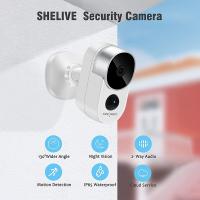How Long Do Security Cameras Keep Footage?
Security cameras have become an integral part of modern security systems, providing a sense of safety and a means to monitor and record activities in various settings. One of the most common questions that arise regarding security cameras is, "How long do security cameras keep footage?" The answer to this question can vary significantly based on several factors, including the type of camera, storage capacity, recording settings, and the specific needs of the user. In this article, we will delve into these factors to provide a comprehensive understanding of how long security cameras typically retain footage and what considerations should be taken into account when setting up a surveillance system.
Factors Influencing Footage Retention

1. Type of Security Camera System
There are different types of security camera systems, each with its own method of storing footage. The most common types include:
- DVR (Digital Video Recorder) Systems: These systems typically use hard drives to store footage. The retention period depends on the storage capacity of the hard drive and the quality of the video being recorded.
- NVR (Network Video Recorder) Systems: Similar to DVR systems, NVRs also use hard drives for storage but are designed for IP cameras. The retention period is influenced by the same factors as DVR systems.
- Cloud-Based Systems: These systems store footage on remote servers. The retention period is usually determined by the subscription plan, with options ranging from a few days to several months.
- Local Storage Systems: Some cameras use SD cards or other local storage methods. The retention period is limited by the storage capacity of the card or device.
2. Storage Capacity
The amount of storage available is a critical factor in determining how long footage can be retained. Larger storage capacities allow for longer retention periods. For example, a system with a 1TB hard drive will store more footage than a system with a 500GB hard drive, assuming all other factors are equal.
3. Video Quality and Compression
Higher resolution video requires more storage space. A camera recording in 4K resolution will use up storage much faster than one recording in 1080p or 720p. Additionally, the type of video compression used (e.g., H.264, H.265) can impact storage requirements. More efficient compression methods can reduce the amount of space needed to store footage without significantly compromising quality.
4. Recording Settings
Security cameras can be set to record continuously, on a schedule, or only when motion is detected. Continuous recording will fill up storage more quickly than motion-activated recording. Adjusting these settings based on the specific needs of the surveillance area can help manage storage usage and extend retention periods.
5. Legal and Regulatory Requirements
In some industries or regions, there may be legal requirements dictating how long surveillance footage must be retained. For example, certain businesses may be required to keep footage for a minimum period to comply with regulations. It is essential to be aware of and adhere to any such requirements.
Typical Retention Periods

Given the various factors that influence footage retention, the typical retention periods can vary widely. However, some general guidelines can be provided:
- Home Security Systems: For residential use, footage is often retained for 7 to 30 days. This period is usually sufficient for homeowners to review any incidents that may have occurred.
- Small Businesses: Small businesses may retain footage for 30 to 90 days, depending on the volume of activity and the importance of the footage.
- Large Enterprises: Larger organizations with more extensive security needs may retain footage for several months or even years. This is particularly true for industries with stringent regulatory requirements.
Best Practices for Managing Footage Retention

To ensure that your security camera system is effectively managing footage retention, consider the following best practices:
1. Assess Your Needs
Evaluate the specific needs of your surveillance system. Consider factors such as the level of activity in the monitored area, the importance of the footage, and any legal requirements. This assessment will help determine the appropriate retention period and storage capacity.
2. Optimize Storage Usage
Adjust recording settings to optimize storage usage. For example, use motion-activated recording instead of continuous recording in areas with low activity. Additionally, consider using more efficient video compression methods to reduce storage requirements.
3. Regularly Review and Delete Unnecessary Footage
Establish a routine for reviewing and deleting footage that is no longer needed. This practice helps free up storage space and ensures that important footage is retained for the necessary period.
4. Invest in Adequate Storage Solutions
Ensure that your security camera system has sufficient storage capacity to meet your retention needs. This may involve upgrading hard drives, adding additional storage devices, or subscribing to a cloud storage plan with adequate retention options.
5. Stay Informed About Legal Requirements
Stay informed about any legal or regulatory requirements that apply to your industry or region. Ensure that your footage retention practices comply with these requirements to avoid potential legal issues.
The question of how long security cameras keep footage does not have a one-size-fits-all answer. The retention period depends on various factors, including the type of camera system, storage capacity, video quality, recording settings, and legal requirements. By understanding these factors and implementing best practices for managing footage retention, you can ensure that your security camera system effectively meets your surveillance needs while optimizing storage usage. Whether for home security, small business, or large enterprise, careful planning and management of footage retention are essential for maintaining a reliable and efficient surveillance system.



















